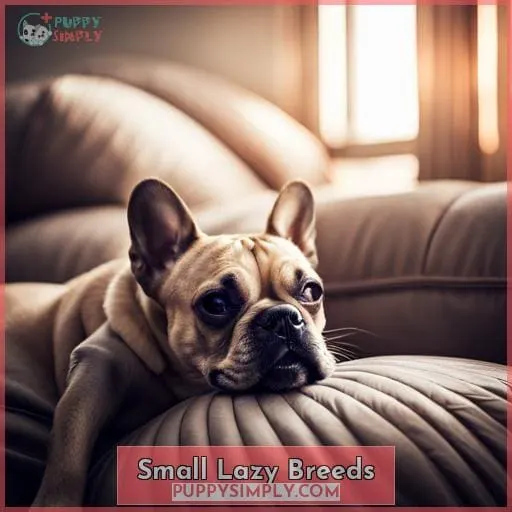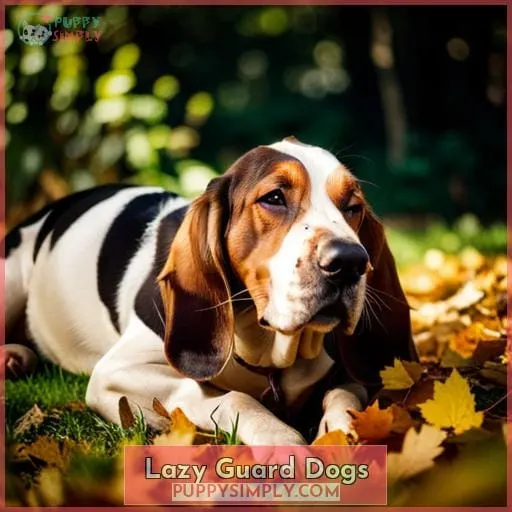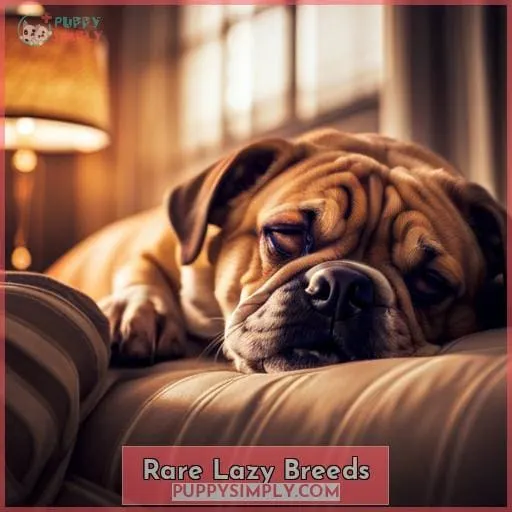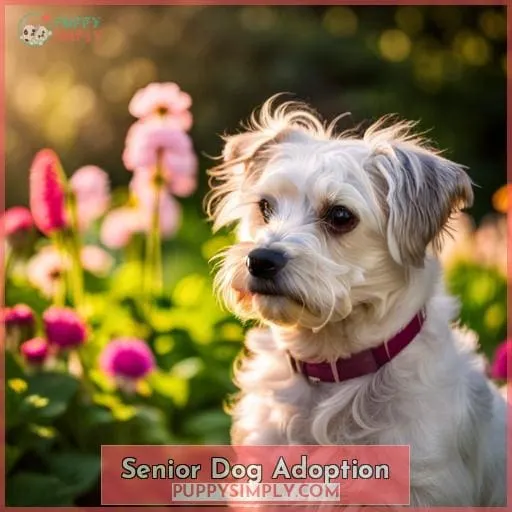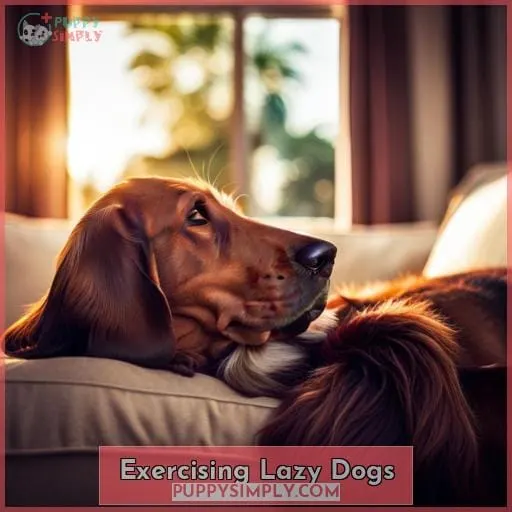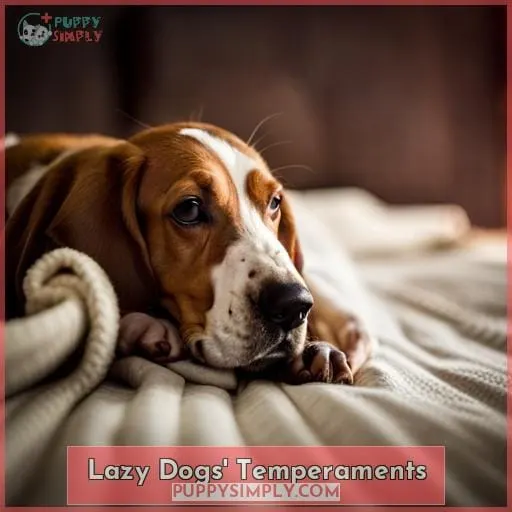This site is supported by our readers. We may earn a commission, at no cost to you, if you purchase through links.
 As your vet, I want what’s best for you and your future furry friend.
As your vet, I want what’s best for you and your future furry friend.
Choosing a low-energy dog lets you bond while respecting needs and limitations.
Laidback pups like French Bulldogs await afternoon cuddles as you read on the couch.
Their gentle temperament builds connection, and moderate exercise keeps them healthy and happy.
Now go meet your perfect match!
Table Of Contents
Key Takeaways
- French Bulldogs and Cavalier King Charles Spaniels are affectionate, low-maintenance companions that don’t require much exercise.
- Basset Hounds, Bloodhounds, and Chow Chows are calm, devoted breeds that prefer mental stimulation over physical activity.
- Spinone Italianos, Miniature Greyhounds, and Pomeranians are rare breeds with mellow personalities.
- Senior dog adoptions can make great low-key companions for the right owners.
Best Dogs for Low Energy
When seeking a low-maintenance canine companion, consider lazy breeds like the French Bulldog or Cavalier King Charles Spaniel.
Both make affectionate and charming house pets, while requiring less exercise than other breeds.
Let’s explore what makes these dogs well-suited for less active owners:
French Bulldog
You’ll love the French Bulldog’s easygoing nature, which makes them an ideal companion for laidback owners seeking a low-maintenance pup.
As a lazy breed suited for apartment living, French Bulldogs boast affectionate temperaments and low exercise needs, making them excellent senior companions.
Though small, they have huge personalities and thrive on quality time with their families.
Monitor their health and weight, as obesity can be an issue.
Overall, Frenchies require minimal grooming and can happily lead the quiet life right by your side.
Cavalier King Charles Spaniel
Between their sweet temperament and couch potato tendencies, you’d find the Cavalier King Charles Spaniel to be among the best companions for low-key owners seeking affectionate canine friends.
Known for their friendly nature and adaptability, Cavaliers have lesser exercise requirements compared to more active breeds. However, they still need regular walks and mental stimulation to keep them happy and healthy.
Grooming needs include regular brushing due to their long coat.
Common health concerns may include heart conditions or knee problems.
Cavalier Traits, Training Tips, Health Concerns, Companion Qualities
Big Lazy Breeds
When thinking big, two giant yet lazy breeds come to mind: the Great Dane and the Mastiff.
Both of these gentle giants are content with short walks and quality time on the couch.
However, their large size does require some extra considerations around the house:
- Space
- Feeding
- Access to water
Great Dane
One calmer big breed is the Great Dane. You’ll find they’re often patient and mild-mannered dogs who love lounging around the house.
As giant breeds, Danes require careful attention to their health with regular vet checks, nutrition planning, and moderate activity to avoid obesity.
Socialize Danes young to offset their protective instincts.
Senior Danes benefit from joint supplements, comfortable beds, and harness support when walking.
With positive, reward-based training, these gentle giants can be wonderful companions.
Mastiff
Another giant breed suited to laidback owners is the Mastiff.
You’d be getting an easygoing guard dog that thrives with limited activity as long as it has space to lounge around.
With their massive frames and generally calm temperaments, Mastiffs make loyal guardians that don’t require intense activity.
Due to their substantial size, be prepared for extra costs associated with feeding, grooming, and veterinary care.
Mastiffs also tend to drool and shed more than average.
Small Lazy Breeds
Havanese and Shih Tzus make excellent choices if you’re looking for a diminutive companion lacking big exercise needs.
Both toy breeds will be quite content lounging around your living room for a good chunk of the day.
However, some daily activity is still essential to maintain their health and prevent obesity.
Havanese
You’ll love the Havanese.
As a small, smart, and social lap dog, they don’t demand much physical activity from you.
Though energetic at times, they’re content to lounge around the house.
Their long, silky coat requires regular brushing to prevent matting.
Havanese thrive on positive interactions, so set aside playtime and training sessions for mental enrichment.
Remaining alert to health issues like hip dysplasia helps them stay active couch potatoes into their senior years.
Shih Tzu
The Shih Tzu is your quintessential companion dog that doesn’t require much exercise.
Despite their long, silky coats requiring daily brushing to prevent matting, they thrive in apartments.
Their affectionate, gentle natures make them ideal for seniors seeking loyal pals.
Still, all dogs need some activity and mental stimulation – regular short walks and play sessions keep your Shih Tzu healthy and happy.
Lazy Hunting Dogs
When thinking of hunting breeds, high energy often comes to mind.
However, the Basset Hound and Bloodhound are two low-maintenance scent hounds perfect for lazy owners.
Though bred for endurance, they tend to be calm and cuddly couch potatoes at home as long as their modest exercise needs are met.
Basset Hound
Finding a scent trail and pursuing it slowly suits your Basset Hound’s lazy temperament.
As scent hounds bred for hunting, Basset Hounds use their superb sense of smell to pick up and follow trails at an unhurried pace.
Their short legs and long ears sweep scents from the ground, making them skilled trackers.
At home, these easygoing dogs love lounging on the sofa and cuddling up next to their owners.
Their gentle, affectionate nature and low-energy lifestyle adapt well to relaxed households seeking loyal companions.
Bloodhound
You’re welcoming another laidback companion by adopting a bloodhound, whose superb sense of smell makes up for a lack of energy or motivation for extensive activity.
Consider that bloodhounds have:
- Legendary tracking abilities used by law enforcement.
- Calm, patient dispositions fitting low-key households.
- Scent skills allowing mental stimulation without much physical activity.
Their tracking talents satisfy their minds without needing lengthy walks or jogs.
Senior bloodhounds available through rescues make devoted, mellow friends.
Lazy Guard Dogs
When choosing a guard dog breed, consider the Chow Chow or Bulldog.
These protective breeds tend to have lower energy levels and enjoy lounging around the house.
However, they still require regular exercise and training to prevent behavior issues.
Chow Chow
You’ll find the Chow Chow makes an excellent lazy guard dog breed with its devoted yet independent nature.
This Chinese breed is loyal and affectionate with families but aloof with strangers, making them natural protectors.
Their grooming needs are moderate with weekly brushing required.
Early socialization and training are essential to curb their stubborn streak.
With proper care, Chow Chows thrive as laidback companions.
| Exercise Needs | Grooming | Trainability |
|---|---|---|
| Low | Medium | Challenging |
Bulldog
You’re looking at the Bulldog next. This laidback breed is loyal and low-maintenance, making it an excellent lazy guard dog.
Bulldogs are known for their relaxed nature and don’t require excessive exercise. However, it’s important to ensure they get regular physical activity to maintain their overall health.
French Bulldog training should focus on positive reinforcement techniques due to their sensitive nature.
Grooming tips for Bulldogs include regular brushing and cleaning of facial folds to prevent infections.
Water Loving Low Energy Dogs
If you’re seeking a laidback dog that enjoys swimming and water play, some low-key breeds like Newfoundlands and Bernese Mountain Dogs can make great companions while requiring less exercise than other water dogs.
Water play provides three key benefits for less active pups:
- Mental Stimulation
- Physical Conditioning
- Stress Relief
Though breeds like Newfoundlands thrive outdoors, you can provide aquatic exercise through indoor hydrotherapy pools.
When properly socialized, water-loving breeds like Newfoundlands can become devoted family companions that enjoy lounging around the house.
With proper care and training, water-loving dogs can thrive even in low-energy homes.
Rare Lazy Breeds
Since water-loving dogs like Newfoundlands love exercising by swimming or playing in water, you’d also be interested to know that some rare breeds, like the Spinone Italiano, require little physical activity.
As a rare Italian hunting dog, the Spinone is a low-energy companion that enjoys leisurely walks and relaxing on the couch.
Other uncommon lazy breeds include the miniature Greyhound, mellow Pomeranian, aloof Chinese Crested, and affectionate Japanese Chin.
While not as popular, these canines have delightful temperaments suited for laidback owners seeking loyal, low-maintenance friends.
Still, every dog deserves proper exercise and care, even rare lazy breeds.
With understanding and patience, these uncommon low-energy companions can enrich our lives immeasurably.
Senior Dog Adoption
Eight. You’re adopting an older or senior dog who likely has lower energy levels requiring less activity.
Senior canine companions available for adoption often come with four considerations:
- They may have some health issues requiring medication or treatment.
- They’ll need time to adjust to a new home. Be patient.
- Their dietary needs may differ from a younger dog’s.
- Emotional support and bonding takes effort but brings great rewards.
Despite potential adoption challenges, senior dogs can make excellent low key companions.
With proper health care and your understanding, senior dogs needing homes can find adoption success and provide you loyalty and affection.
Open your heart and home to a gentle spirit.
Exercising Lazy Dogs
From adopting a senior dog, you’d still need to take even lazy breeds out for some activity to maintain their health.
Though low-energy dogs require less exercise, regular indoor play sessions, short walks, or contained backyard activity helps them stay fit.
Mental games like hide-and-seek or food puzzle toys also stimulate them.
Grooming like brushing helps lazy dogs bond while keeping their coat healthy.
With minimal space needed, lazy breeds suit apartments if given adequate indoor activity.
Still, ensure any senior dog adoptee visits the vet, receives medications as needed, and eats quality food despite their lazy tendencies.
Supervise playtime to prevent injuries as well.
| Indoor Activities | Outside Time |
|---|---|
| Food puzzles | Short walks |
| Hide-and-seek | Backyard play |
| Training games | Occasional hikes |
| Brushing grooming | Visits to dog park |
| Trick practice | Swimming outings |
Lazy Dogs’ Temperaments
Most of these low-energy breeds have easygoing, patient temperaments that make them well-suited for relaxed owners.
As your veterinarian, I must advise that while breeds like Bulldogs, Mastiffs, and Great Danes tend to be calm and mild-mannered, individual personalities vary.
Pay attention to subtle temperament traits before adoption.
For instance, Chow Chows can be stubborn and suspicious of strangers despite their typically independent nature.
Havanese and Cavalier King Charles Spaniels display smart, social temperaments requiring interactive play.
When compatible with your lifestyle, training low-energy dogs presents few difficulties.
Their eager-to-please personalities respond well to positive reinforcement techniques.
Overall, lazy personalities mean less destructive behavior, but beware of obesity without proper exercise.
Matching breed traits to your own creates rewarding bonds.
Frequently Asked Questions (FAQs)
What are some easy-to-train lazy dog breeds for first-time owners?
Consider easygoing breeds like French Bulldogs or Havanese.
As first-time owners, focus on patient, friendly dogs that will thrive in your home with modest exercise needs.
Avoid more stubborn or territorial breeds until you’ve developed experience meeting canines’ basic care and training requirements.
Do lazy dogs bark less than more active breeds?
Yes, lazy dogs tend to bark less than more active breeds.
Their calm temperaments mean they usually only vocalize for specific reasons, not excessively.
However, some lazy breeds like Mastiffs will still bark as part of their guarding instinct.
Ultimately, each dog’s tendency to bark depends on their individual personality.
How much living space do small lazy dog breeds require?
Small companion breeds like Chihuahuas and Yorkies thrive in studio apartments, needing only a comfy bed and attentive human.
Still, any dog requires daily enrichment – even just one walk fuels their spirit.
What matters most is a home filled with patience, affection, and room in your heart.
What health issues are common in lazy large dog breeds?
Many large, low energy dog breeds like Mastiffs, Danes, and Saint Bernards are prone to joint issues.
Regular low-impact exercise helps maintain mobility and healthy weight, reducing arthritis risk.
These breeds’ facial folds need diligent cleaning, as yeast and bacteria thrive in moist areas.
Routine ear cleaning prevents infections.
Their size predisposes them to gastric twisting, so don’t overfeed or exercise too soon after eating.
Comply with spay/neuter recommendations to prevent health complications later on.
What lazy hunting or working dog breeds can adapt well to family life?
Let’s consider some easygoing hunting and working breeds.
Newfoundlands love lounging but relish romps.
Mastiffs might seem massive, yet many mellow mutts make merry, mild-mannered family members.
What matters most is meeting each dog’s unique needs through nurturing.
Every pup appreciates playtime and pals.
Conclusion
Have you found your perfect low-energy furry companion?
As your trusted vet, I urge you to thoughtfully consider breed traits and needs before making this lifelong commitment.
Lazy days await with the right gentle giant or petite pup, but be ready to provide adequate walks, training, and affection.
With understanding and patience, might you both find comfort and connection in the simplest of pleasures – your presence by one another’s side?
Now go make those new memories!



